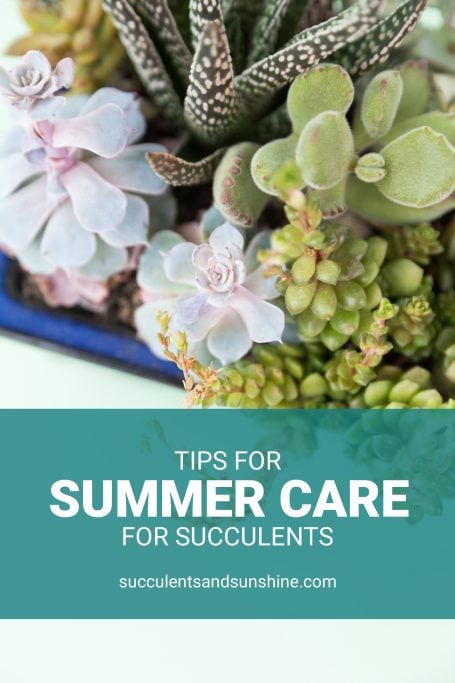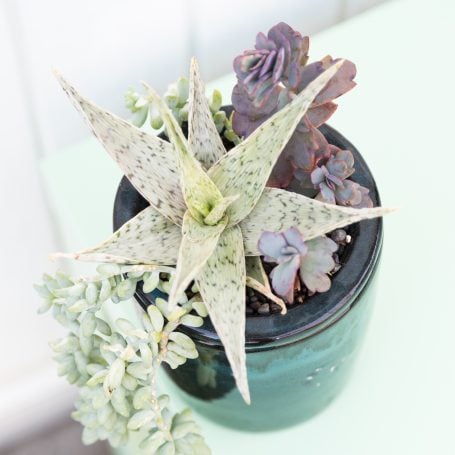Discover the steps necessary to make the transition from inside to outside for your indoor succulents when the weather begins to warm. Giving them access to fresh air and more sunshine will help your plants thrive.
When you buy something using the links on this website, we may receive a commission at no additional cost to you. This helps us create and offer free content for everyone to enjoy.
It is common to find outdoor succulents looking healthier and more attractive than those grown indoors. Two major components that contribute to this are increased sunlight exposure, which avoids over-stretching, as well as improved airflow which helps to keep the roots from becoming overly saturated.
I suggest giving your indoor succulents a chance to experience the summer weather by taking them outdoors for a bit.
When engaging in this activity, it is important to be aware of certain considerations.
Table of Contents
When to plant succulents in the spring
Is it too early to plant new succulents outdoors?
It’s recommended to wait until after the final frost and when the temperatures no longer drop below 40F at night before you plant succulents outside. Planting earlier may be possible, but you’re more likely to achieve success when the weather is warmer.
Don’t put off planting your succulents until the summertime; the heat can be as much of a challenge as the cold. Aim for a moderate temperature of 50-70F to get the best results when planting outdoors.
Ease them into the sunlight and heat
You should introduce your succulents to sunlight gradually to avoid burning them. Begin by placing them in a spot that receives full shade, and slowly transition them to areas with more direct sunlight.
Larger, more established succulents are more tolerant of bright light and warm temperatures, while recently planted succulents should remain in the shade for an extended period of time.
Suggestion: Consider exposing your succulents to more sunshine by adding an extra hour or two of morning sunlight per week. This time of day is cooler, which is beneficial for succulents.
Ensure that you are aware of the amount of shade available to your plants throughout the day. I made the mistake of placing my succulents in an uncovered wire rack on the east side of my house this year, resulting in them getting burned in the sun. To prevent this from happening again, I have built a roof that hangs over the rack to provide more shade during the day.
I was unaware that my garden receives full sunlight until the afternoon. This level of exposure was too intense for the plants I was propagating, in particular the leaves.
Take my advice and let your plants acclimate to the extra light and higher temperatures by keeping them in full shade for a few days. Afterward, move them to an area that gets morning sun, and after a few more days, they should be ready to be placed in their permanent spot.
Be mindful of the early warning signs of sunburn in your succulents, such as bleaching or a significant color change. If you detect these symptoms, move your plants to a spot with less sunlight.
Fertilize
Spring is an excellent period to provide succulents with fertilizer. Due to the end of dormancy, these plants are now ready to grow. Adding some nutrients will help them regain their vibrant colors and produce new, healthy growth!
I highly suggest trying Haven Manure Tea. I had a great experience with it and wrote a blog post about it with some before and after pictures.
Use Pot Feet
Propagate
It’s probable that your succulents have grown quite tall over the winter. Echeverias appear to really elongate, while Aloes generally maintain their form better. Now is a perfect time to snip off the top of the succulent and propagate it!
For further information about propagating, please refer to my book.
Repot if necessary
If your succulent or the other plants in the pot have experienced significant growth over the winter, or if some of the plants have perished, you may need to repot them. Carefully remove the plants from the old soil, shaking off as much soil as you can. Give the pot a thorough clean with some soapy water (followed by a rinse) or spray with isopropyl alcohol, and then replant with new soil.
If you’ve had your succulents in the same container for a while, giving them a change of soil and a fresh pot can be beneficial. It’s a great way to spruce up your succulents for the summer season.
Watch for bugs
Mealybugs are drawn to plants that grow rapidly, so be vigilant after transferring your plants to new places. Ants often transport mealybugs from one plant to another, so it’s important to be aware of this possibility.
If you spot mealybugs, eliminate them by pouring alcohol on them. Check out my comprehensive guide on how to deal with mealybugs for more information.
You may observe other creatures being attracted to your succulents. Slugs and snails can wreak havoc on your plants if not prevented. In addition, larger animals such as squirrels, raccoons, birds, cats and dogs may be drawn to the succulents and cause destruction. If this happens, you may need to bring your succulents indoors. However, any outdoor time is better than none!
Take heed when transitioning your plants from indoors to outdoors for the summer season. From my own experience, it is disheartening to accidentally harm one’s plants due to a lack of care.
It’s a good idea to relocate your plants so they can get more fresh air and sunshine, which will help them thrive.
Make sure to provide your plants with indirect sunlight, fertilize them, propagate if needed, repot if needed and inspect for any signs of pests or insects.
FAQ
Are succulents happier inside or outside?
You should bring the plants inside if the outside environment does not suit their particular needs. If the sunlight, temperature, or hardiness zone do not match what the plants require, it is best to move them indoors.
Why my succulents are dying in summer?
Experts indicate that in order to keep succulents alive and healthy, it is necessary to avoid overwatering, provide sufficient lighting, and keep temperatures at a reasonable level. Proper care is essential for the longevity of succulents.
Can succulents live outside in full sun?
Succulents thrive when they are exposed to full sun. Their leaves will be plump and vibrant in this light, and they will be lively and healthy. Without enough sunshine, the succulents will become spindly, bleached, and lopsided.
How do you keep succulents alive in the summer?
Watering your succulents in the morning is ideal in the summertime. This helps prevent the water from getting too hot and potentially burning the plant if it sits in the crown of the succulent. It is best to avoid watering in the afternoon when temperatures are highest.
Can succulents get too much sun?
Some succulents can tolerate bright light, but not all can handle extended periods of direct sunlight (6+ hours per day). Too much sun can cause the leaves to burn, and they will turn brown or black, and may start to wrinkle or form calluses.


